Submitted:
06 July 2023
Posted:
10 July 2023
You are already at the latest version
Abstract
Keywords:
1. Introduction
2. Materials and Methods
3. Results and Discussion
4. Conclusions
5. Patents
Acknowledgments
References
- Tao, A.; Yao, T.; Jiang, Y.; Yang, L.; Yan, X.; Ohta, H.; Ikuhara, Y.; Chen, C.; Ye, H.; Ma, X. Single-dislocation Schottky diodes. Nano Lett. 2021, 21, 5586–5592. [Google Scholar] [CrossRef]
- Chang, K.E.; Yoo, T.J.; Kim, C.; Kim, Y.J.; Lee, S.K.; Kim, S.Y.; Heo, S.; Kwon, M.G.; Lee, B.H. Gate-controlled graphene–silicon Schottky junction photodetector. Small 2018, 14, 1801182. [Google Scholar] [CrossRef]
- Yang, W.; Chen, J.X.; Zhang, Y.; Zhang, Y.J., He; Fang, X.S. Silicon-compatible photodetectors: Trends to monolithically integrate photosensors with chip technology. Adv. Funct. Mater. 2019, 29, 1808182. [Google Scholar] [CrossRef]
- Liu, C.; Guo, J.; Yu, L.; Li, J.; Zhang, M.; Li, H.; Shi, Y.; Dai, D. Silicon/2D-material photodetectors: From near-infrared to mid-infrared. Light: Sci. Appl. 2021, 10, 123. [Google Scholar] [CrossRef] [PubMed]
- Kang, Z.; Ma, Y.; Tan, X.; Zhu, M.; Zheng, Z.; Liu, N.; Li, L.; Zou, Z.; Jiang, X.; Zhai, T.; et al. MXene–silicon van der Waals heterostructures for high-speed self-driven photodetectors. Adv. Electron. Mater. 2017, 3, 1700165. [Google Scholar] [CrossRef]
- Wan, X.; Xu, Y.; Guo, H.; Shehzad, K.; Ali, A.; Liu, Y.; Yang, J.; Dai, D.; Lin, C.; Liu, L.; et al. A self-powered high-performance graphene/silicon ultraviolet photodetector with ultra-shallow junction: Breaking the limit of silicon? NPJ 2D Mater. Appl. 2017, 1, 4. [Google Scholar] [CrossRef]
- Song, W.; Liu, Q.; Chen, J.; Chen, Z.; He, X.; Zeng, Q.; Li, S.; He, L.; Chen, Z.; Fang, X. Interface engineering Ti3C2 MXene/silicon self-powered photodetectors with high responsivity and detectivity for weak light applications. Small 2021, 17, 2100439. [Google Scholar] [CrossRef] [PubMed]
- Song, L.; Xu., E.; Yu, Y.; Jie, J.; Xia, Y.; Chen, S.; Jiang, Y.; Xu, G.; Li, D.; Jie, J. High-barrier-height Ti3C2Tx/Si microstructure Schottky junction-based self-powered photodetectors for photoplethysmographic monitoring. Adv. Mater. Technol. 2022, n/a, 2200555. [Google Scholar] [CrossRef]
- Ollearo, R.; Ma, X.; Akkerman, H.B.; Fattori, M.; Dyson, M.J.; van Breemen, A.J.J.; Meskers, S.C.J.; Dijkstra, W.; Janssen, R.A.J.; Gelinck, G.H. Vitality surveillance at distance using thin-film tandem-like narrowband near-infrared photodiodes with light-enhanced responsivity. Sci. Adv. 2023, 9, eadf9861. [Google Scholar] [CrossRef]
- Simone, G.; Tordera, D.; Delvitto, E.; Peeters, B.; van Breemen, A.J.J.; Meskers, S.C.J.; Janssen, R.A.J.; Gelinck, G.H. High-accuracy photoplethysmography array using near-infrared organic photodiodes with ultralow dark current. Adv. Opt. Mater. 2020, 8, 1901989. [Google Scholar] [CrossRef]
- Nowara, E.M.; Marks, T.K., Mansour; Veeraraghavan, A. near-infrared imaging photoplethysmography during driving. IEEE Trans. Intell. Transp. Syst. 2022, 23, 3589–3600. [Google Scholar] [CrossRef]
- Zhang, H.; Cui, Y.; Lu, M.; Yang, Q.; Feng, J.; Chen, S.; Yang, X.; Xu, G.; Yu, Y. Self-filtered NIR photodetectors based on silicon micro-holes array for stable heart rate monitoring. IEEE Electron Device Lett. 2022, 43, 2129–2132. [Google Scholar] [CrossRef]
- Charlton, P.H.; Kyriacou, P.A.; Mant, J.; Marozas, V.; Chowienczyk, P.; Alastruey, J. Wearable Photoplethysmography for cardiovascular monitoring. Proc. IEEE 2022, 110, 355–381. [Google Scholar] [CrossRef]
- Sun, Y.; Thakor, N. Photoplethysmography revisited: From contact to noncontact, from point to imaging. IEEE Trans. Biomed. Eng. 2016, 63, 463–477. [Google Scholar] [CrossRef] [PubMed]
- Spigulis, J.; Gailite, L.; Lihachev, A.; Erts, R. Simultaneous recording of skin blood pulsations at different vascular depths by multi-wavelength photoplethysmography. Appl. Opt. 2007, 46, 1754–1759. [Google Scholar] [CrossRef]
- Xu, H.; Liu, J.; Zhang, J.; Zhou, G.; Luo, N.; Zhao, N. Flexible organic/inorganic hybrid near-Infrared photoplethysmogram sensor for cardiovascular monitoring. Adv. Mater. 2017, 29, 1700975. [Google Scholar] [CrossRef]
- Mi, L.; Chang, Y.; Zhang, Y.; Xu, E.; Jiang, Y. Hybrid perovskite exchange of PbS quantum dots for fast and high-detectivity visible–near-infrared photodetectors. J. Mater. Chem. C 2021, 9, 417–438. [Google Scholar] [CrossRef]
- Mi, L.; Wang, H.; Zhang, Y.; Yao, X.; Chang, Ya.; Li, G.; Lei, C.; Li, G.; Jiang, Y. Converting electrical conductivity types in surface atomic-ligand exchanged PbS quantum dots via gate voltage tuning. J. Alloys Compd. 2017, 699, 866–873. [Google Scholar] [CrossRef]
- Mi, L.; Wang, H.; Zhang, Y.; Yao, X.; Chang, Y.; Li, G.; Li, G.; Jiang, Y. High performance visible–near-infrared PbS-quantum-dots/indium Schottky diodes for photodetectors. Nanotechnology. 2017, 28, 055202. [Google Scholar] [CrossRef] [PubMed]
- Lv, P.; Zhang, X.; Zhang, X.; Deng, W.; Jie, J. High-sensitivity and fast-response graphene/crystalline silicon Schottky junction-based near-IR photodetectors. IEEE Electron Device Lett. 2013, 34, 1337–1339. [Google Scholar] [CrossRef]
- Xiang, D.; Han, C.; Hu, Z.; Lei, B.; Liu, Y.; Wang, L.; Hu, W.; Chen, W. Surface transfer doping-induced, high-performance graphene/silicon Schottky junction-based, self-powered photodetector. Small 2015, 11, 4829. [Google Scholar] [CrossRef] [PubMed]
- Li, X.; Zhu, M.; Du, M.; Lv, Z.; Zhang, L.; Li, Y.; Yang, Y.; Yang, T.; Li, X.; Wang, K.; et al. Graphene: High detectivity graphene-silicon heterojunction photodetector. Small 2016, 12, 549–549. [Google Scholar] [CrossRef]
- Adhikari, S.; Biswas, C.M.H.; Doan, M.H.; Kim, S.T.; Kulshreshtha, C.; Lee, Y.H. Minimizing trap charge density towards an ideal diode in graphene-silicon Schottky solar cell. ACS Appl. Mater. Interfaces 2019, 11, 880–888. [Google Scholar] [CrossRef]
- Periyanagounder, D.; Gnanasekar, P.; Varadhan, P.; He, J.H.; Kulandaivel, J. High performance, self-powered photodetectors based on a graphene/silicon Schottky junction diode. J. Mater. Chem. C 2018, 6, 9545–9551. [Google Scholar] [CrossRef]
- Yin, J.; Liu, L.; Zang, Y.; Ying, A.; Hui, W.; Jiang, S.; Zhang, C.; Yang, T.; Chueh, Y.L.; Li, J.; et al. Engineered tunneling layer with enhanced impact ionization for detection improvement in graphene/silicon heterojunction photodetectors. Light: Sci. Appl. 2021, 10, 113. [Google Scholar] [CrossRef] [PubMed]
- Wang, L.; Luo, H.; Zuo, H.J.; Tao, J.; Yu, Y.; Yang, X.; Wang, M.; Hu, J.; Xie, C.; Wu, D.; et al. Highly sensitive narrowband si photodetector with peak response at around 1060 nm IEEE Trans. Electron Devices 2020, 67, 3211–3214. [Google Scholar] [CrossRef]
- Wang, L.; Li, Z.; Li, M.; Li, S.; Lu, Y.; Qi, N.; Zhang, J.; Xie, C.; Wu, C.; Luo, L.B. Self-powered filterless narrow-band p–n heterojunction photodetector for low background limited near-infrared image sensor application, ACS Appl. Mater. Interfaces 2020, 12, 21845–21853. [Google Scholar] [CrossRef] [PubMed]
- Yu, Y.; Li, Z.; Lu, Z.J.; Geng, X.; Lu, Y.; Xu, G.; Wang, L.; Jie, J. Graphene/MoS2/Si nanowires Schottky-NP bipolar van der waals heterojunction for ultrafast photodetectors. IEEE Electron Device Lett. 2018, 39, 1688–1691. [Google Scholar] [CrossRef]
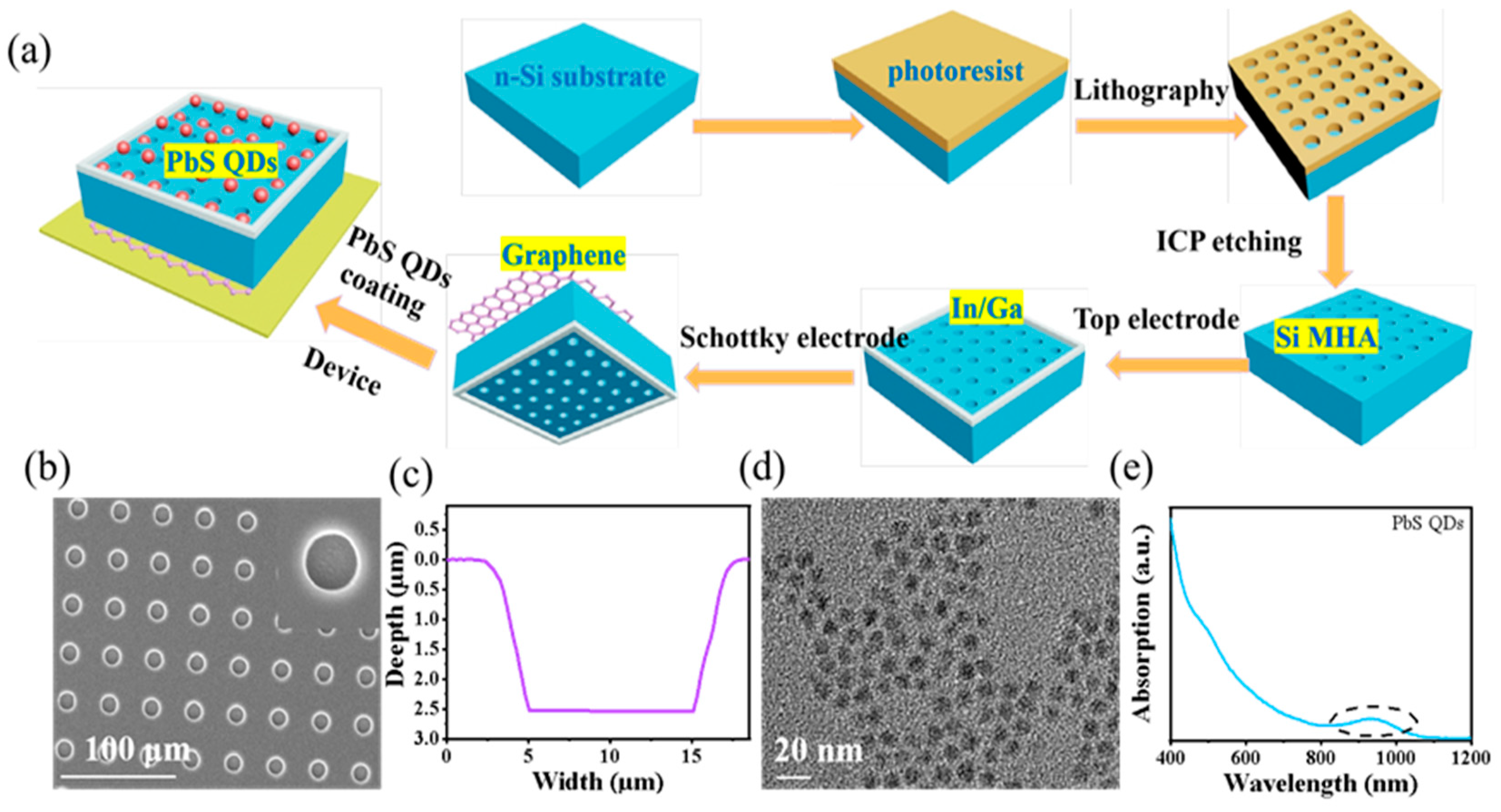
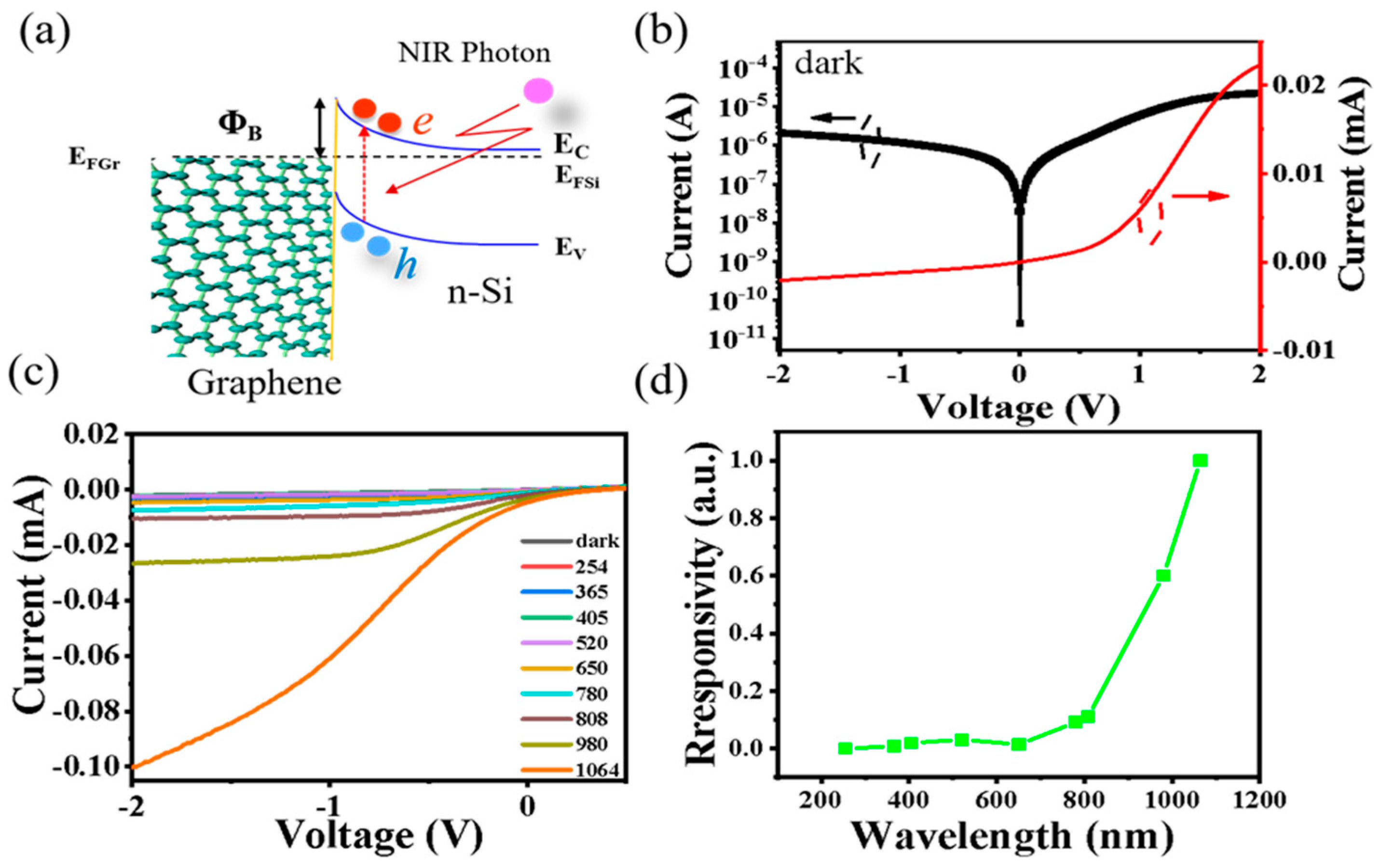
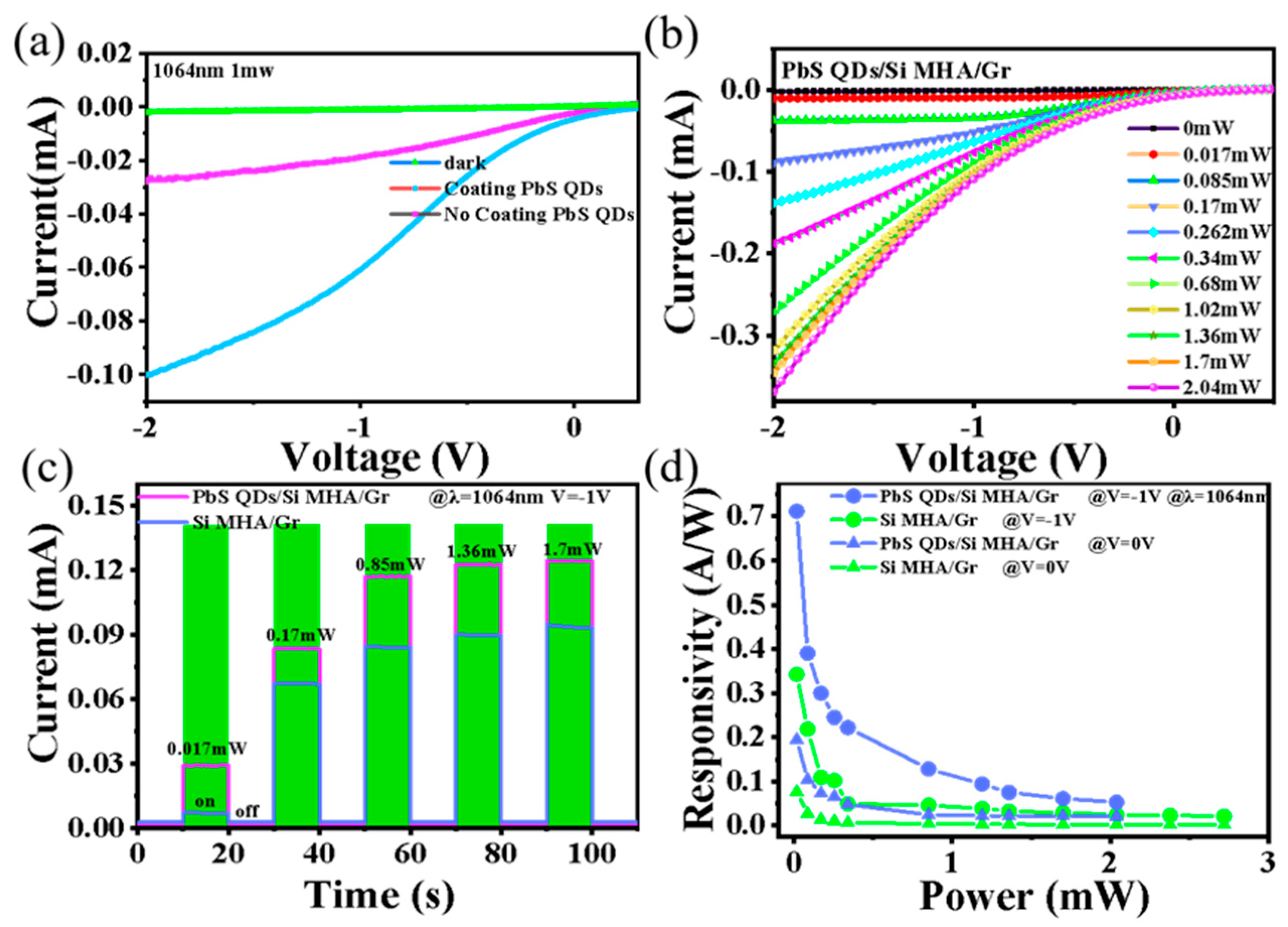
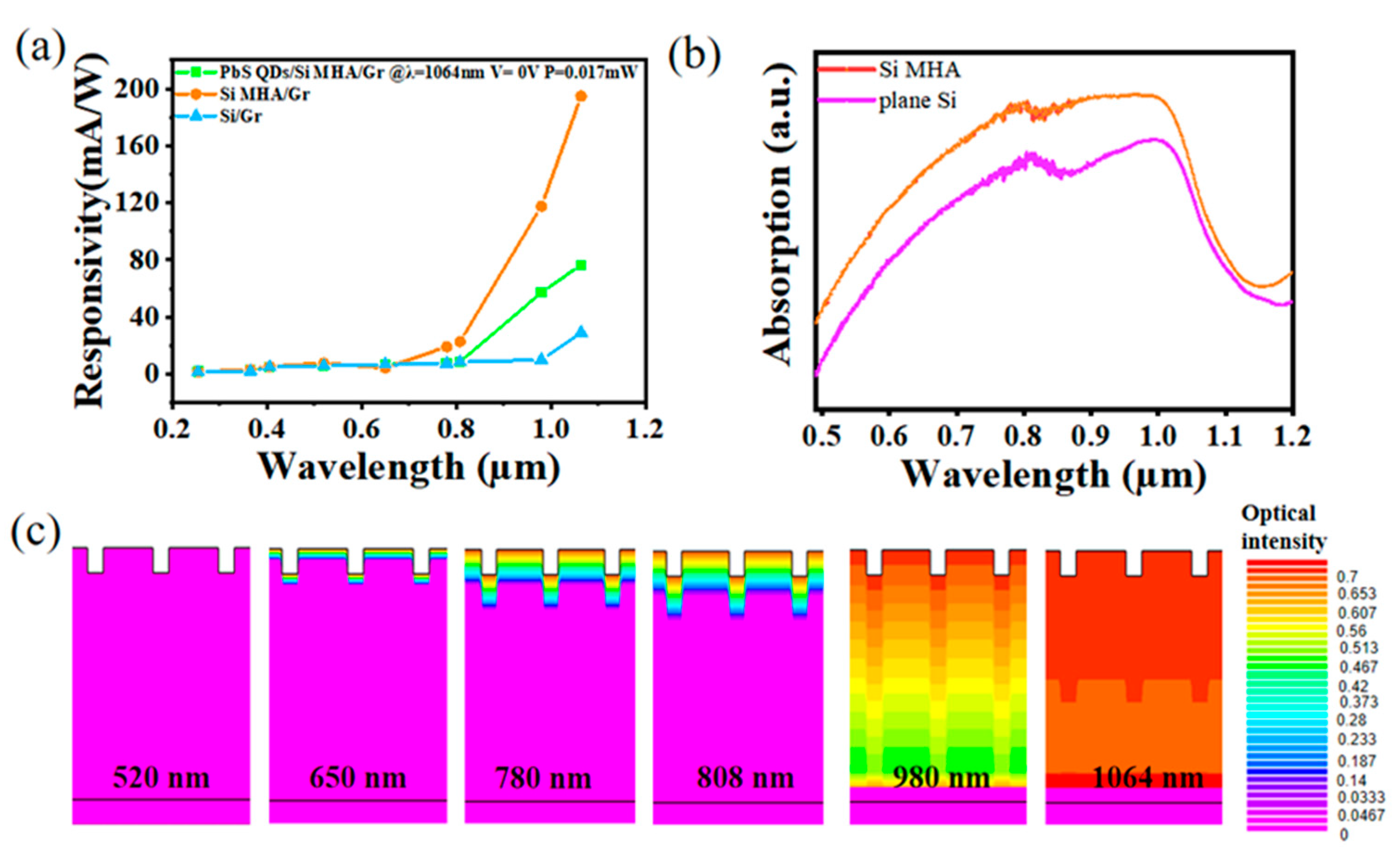
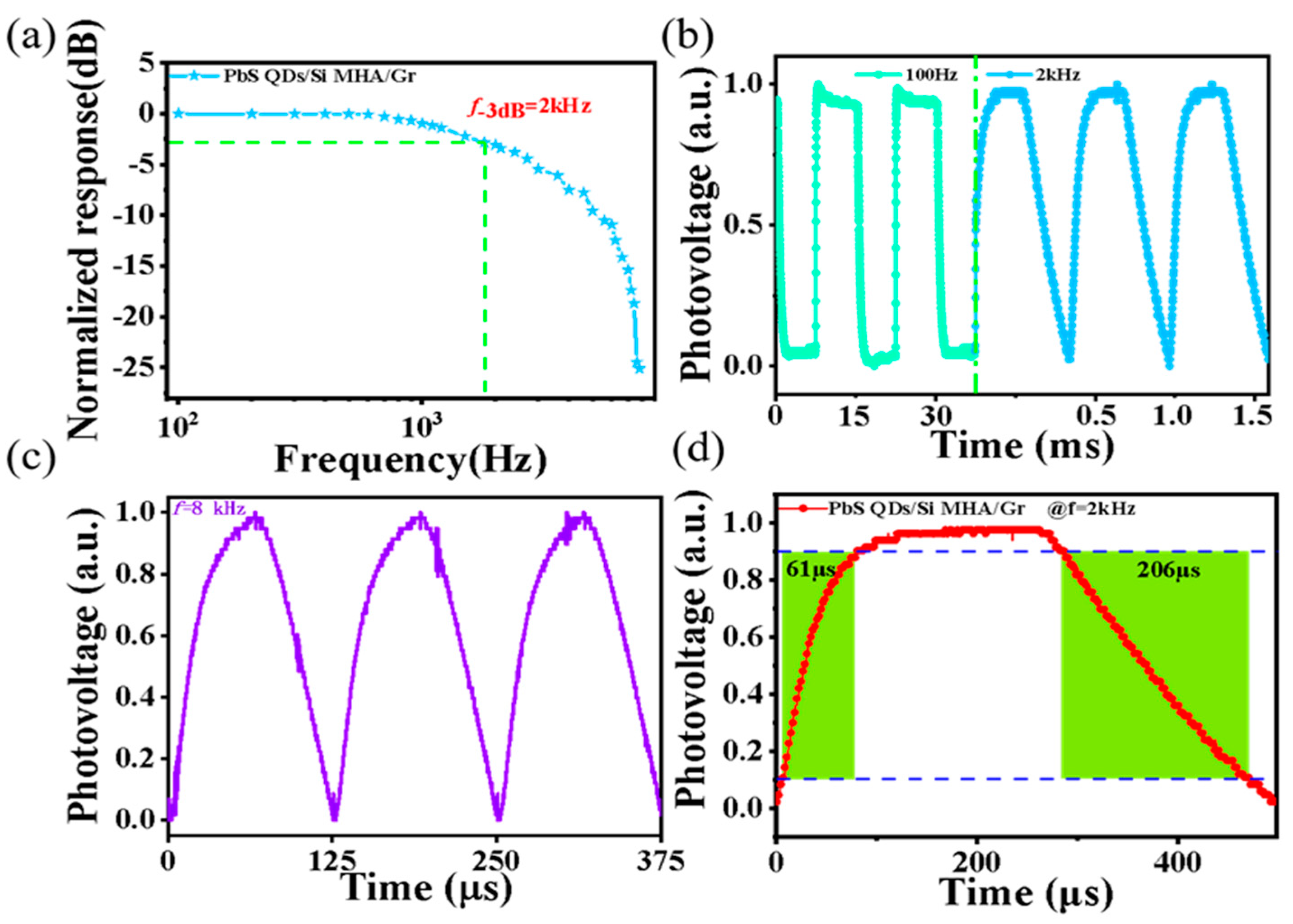
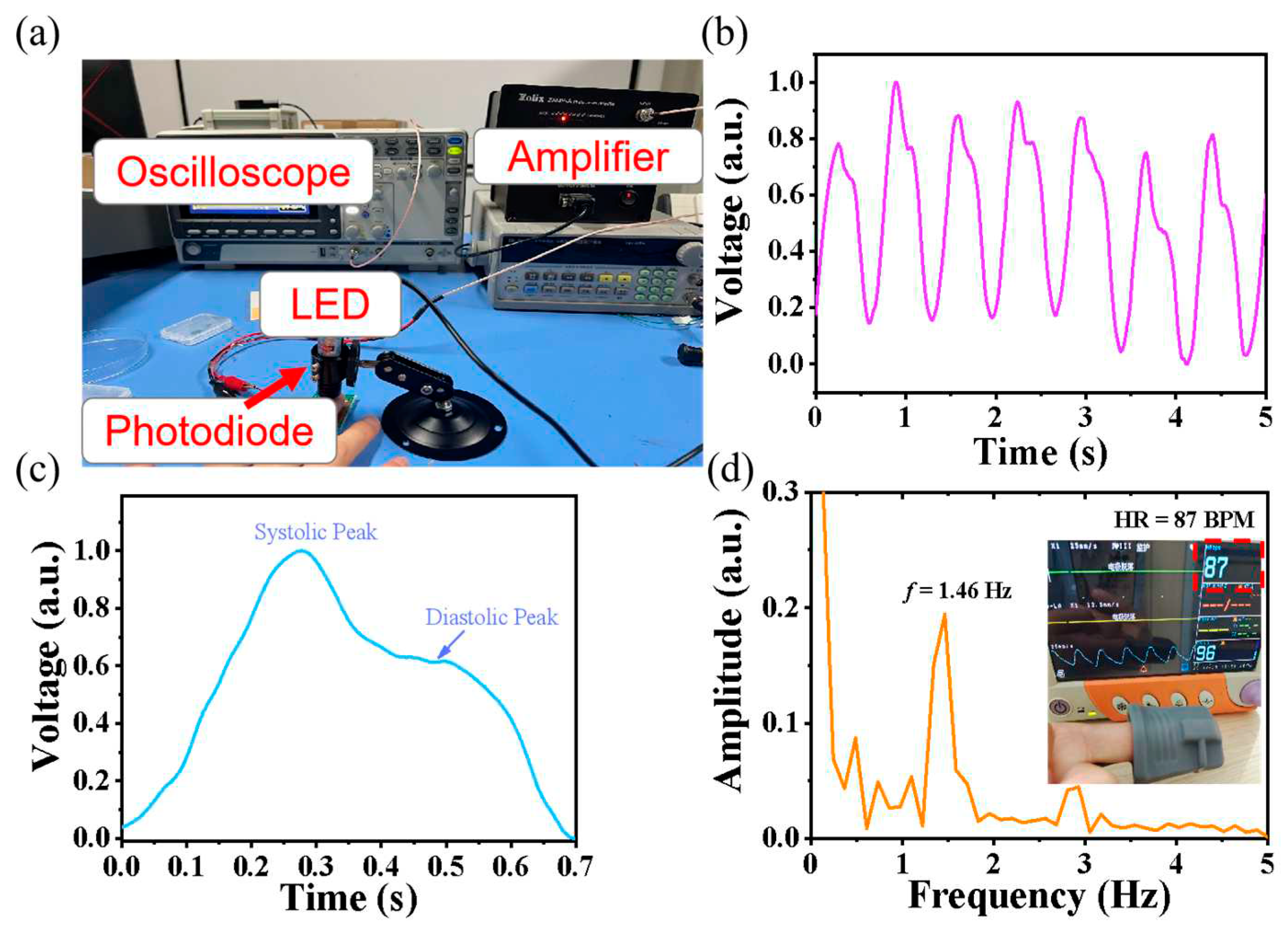
Disclaimer/Publisher’s Note: The statements, opinions and data contained in all publications are solely those of the individual author(s) and contributor(s) and not of MDPI and/or the editor(s). MDPI and/or the editor(s) disclaim responsibility for any injury to people or property resulting from any ideas, methods, instructions or products referred to in the content. |
© 2023 by the authors. Licensee MDPI, Basel, Switzerland. This article is an open access article distributed under the terms and conditions of the Creative Commons Attribution (CC BY) license (http://creativecommons.org/licenses/by/4.0/).




